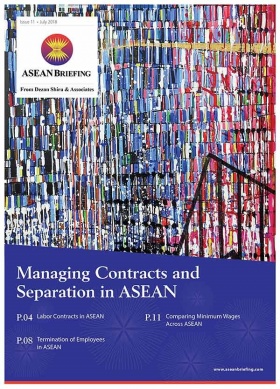Termination of Employees in ASEAN
Terminations come with inherent risks of employees filing lawsuits against employers, and can be expensive. As each country in ASEAN has its own employment law, it is important for multinational companies that operate within the region to ensure that their contracts are in line with the local requirements in each jurisdiction. In this article, we provide a brief overview of statutory regimes in the five major ASEAN countries with respect to employment termination.
Indonesia
Indonesian law requires employers to resolve industrial relations disputes with an employee through bipartite negotiations, followed by mediation or reconciliation. In case an agreement cannot be reached, an employer may only unilaterally terminate an employment relationship if it has a prior order from the Industrial Relations Court (IRC). Until such an order is obtained, the employer is obliged to continue paying the stipulated wages to the employee.
Restricted or prohibited terminations
Legally, Indonesian employers are prohibited from terminating employees on grounds of marriage, race, religion, gender, health, or ideology, as well as work-related sickness that is unlikely to lead to the employee becoming fit for work
Notice period
Indonesian law does not set out any notice period for employment termination. In practice, some employment agreements stipulate a 30-day notice period for termination. However, employers must note that a written notice alone is not sufficient to legally terminate ties with an employee, and employers must first seek approval for the termination from the IRC.
Severance payments
The amount and type of severance to be paid to an employee depends on the basis of the termination of employment. If the termination is due to the employee’s misconduct, the Manpower Law stipulates the following types of severance to be paid to the employee:
- Standard severance pay: One month’s salary for each year of service, up to nine months’ salary.
- Service appreciation pay: Two months’ salary for the first three years of service, followed by an additional month’s salary for every three years of service thereafter, up to a maximum of 10 months’ salary for 24 years of service.
- Monetary compensation: to cover annual leave that has not expired or been taken, medical and housing allowance, relocation expenses (to help the employee and her or his family to return to hometown), other benefits under the employment relationship; and other compensation amounts as determined by the IRC.
If the termination is without cause or there is termination on retirement, the employee is entitled to two times the severance pay amount plus the standard service appreciation pay (if applicable) and compensation. If contested, a termination without cause may result in reinstatement.
Malaysia
Restricted or prohibited terminations
In Malaysia, an employer cannot terminate employment at-will, or dismiss an employee at any time without cause and by mere notice or salary in lieu of notice. A termination may only come about if there is a legal, that is, just or authorized cause for termination and if the employer has followed the procedures required for the cause of termination.
Notice period
Employers and employees alike have the right to terminate a contract. If the labor contract does not specify a mandatory notice period, then either party may provide an interval of notice corresponding with their level of service with the company, which ranges from four weeks for employment periods of less than two years to eight weeks for service duration exceeding five years.
If an employer terminates an employee’s contract without providing the necessary notice, the the employee must then be paid the equivalent wages that they would have received if they had been given notice.
Severance payments
Employees completing less than two years of employment are entitled to 10 days’ wage for every completed year of service. Employees completing two to five years’ employment are entitled to 15 days’ wage for every completed year of service. Employees completing five or more years’ employment are entitled to 20 days’ wages for every completed year of service.
Severance pay is not applicable for employees dismissed for misconduct, who retire, or who voluntarily terminate the contract.
Philippines
Restricted or prohibited terminations
Similar to Malaysia, the Philippines’ labor law does not permit an employer to terminate employment at-will, or dismissing an employee at any time without cause and by mere notice or salary in lieu of notice. An employer may terminate an employee only if there is a legal, that is, just or authorized cause for termination and it has followed the procedures required for the cause of termination.
Notice period
Prior to terminating an employee, the Department of Labor and Employment (DOLE) requires employers to serve two written notices to the employee. First, specifying the ground for termination and seeking the employee’s written explanation indicating their own case for defence within five days of receipt of the first notice; and second, a subsequent formal notice in case when there is sufficient ground to terminate the employee.
Before issuing the second notice, it is mandatory for the employer to conduct a formal hearing or conference if
- the employee requests in writing;
- if there exists substantial conflicting pieces of evidence;
- if the company’s rules or practice requires it; or
- if similar circumstances justify it.
Severance payments
Separation pay is equivalent to at least one month’s pay or at least one month’s pay for each year of service, whichever is higher; a fraction of six months is considered as one year. However, if the ground for termination is retrenchment to prevent serious losses, closure of business or disease, the separation pay shall be equivalent to one month’s pay or 30 days’ pay for every year of service, whichever is higher; a fraction of six months is considered as one year.
Singapore
The EA is the principal statute of legislation governing employment termination in Singapore. For those employees not covered by the EA, termination is governed by the employment contract between employer and employee.
Restricted or prohibited terminations
Employers are prohibited from terminating a contract with employees based on age, if the employee has not reached the prescribed minimum retirement age. Employers are also restricted from terminating employment of a female employee during her maternity leave, or issuing a notice of dismissal during her maternity leave.
Notice period
The notice period conforms to the contractual terms mutually agreed upon by the employer and the employee and stated in the employment contract. However, if a notice term is absent from the contract, the employment Act provides for notice periods ranging from one day for employment periods of less than 26 weeks to four weeks for service duration exceeding five years.
Severance payments
Unless the employment terms expressly provide that severance, retrenchment or redundancy benefits are payable, there is no obligation on the part of the employer to pay such benefits. This is a matter of contract, company policy, subsequent negotiations and financial position, or what has been agreed collectively. When dealing with unionized employees, employers are obliged to negotiate in good faith with the union, and may not have absolute discretion to determine the terms of the retrenchment benefits.
On October 2, 2018, a bill amending certain provisions of the EA was introduced in parliament. Most significantly, claims against wrongful termination will be extended to include constructive dismissal. This implies that an employee may be able to seek redress in instances where the employer creates working conditions that cause the employee to resign without waiting to be terminated by the employer. We will provide further details once these changes are confirmed.
Thailand
Restricted or prohibited terminations
In Thailand, an employer cannot dismiss, reduce the wages of, punish and/or withhold the performance of duty of any employee who is a member of the Employees’ Committee unless permission to do so has been given to the employer by the labor court.
Notice period
Unless the employment agreement is for a fixed-term, the minimum statutory notice period is at least one full payment period in advance of the effective date of termination, or payment of wages in lieu thereof. An employer need not give more than three months’ notice if the actual pay period is more than three months. However, at the same time, an employment contract providing for a notice period exceeding three months is enforceable.
Further, the termination notice must be served on the employee’s payday or in advance, such that the effective date of termination would be the following payday.
Severance payments
An employer who terminates the employment of an employee without any cause attributable to the terminated employee as specified in Thai Labor Protection Act (LPA) must pay a severance payment to the employee at the rate prescribed by the LPA together with other due payments. These range from 30 days’ wages for employment periods of less than a year to 300 days’ wages for service duration exceeding 10 years.
An employee employed under a definite period contract or a project contract whose employment is terminated according to such specified period is not entitled to any severance payment.
Special severance pay
If an employer terminates an employee due to the introduction of machinery or replacement of machinery or application of technology, and such employee has been working for 6 consecutive years or more, the employer is obliged to pay additional special severance pay of not less than the last 15 days’ wage rate per year of employment capped at an amount equal to the last 360 days’ wage rate. For any period of less than a one year, if the fraction of employment period is more than 180 days, it will be rounded up to one full year of employment.
 This article, which has been updated on November 15, 2018, was originally published on September 20, 2018. It is an excerpt from the July 2018 issue of ASEAN Briefing magazine, titled “Managing Contracts and Separation in ASEAN“. In this issue of ASEAN Briefing magazine, we discuss how to manage contracts and separation in five major ASEAN economies – Indonesia, Malaysia, the Philippines, Singapore and Thailand. We begin by describing the salient features of labor contracts and social security obligations. We next discuss the various compliance requirements associated with separation of employees. Finally, we compare current minimum wage rates across ASEAN.
This article, which has been updated on November 15, 2018, was originally published on September 20, 2018. It is an excerpt from the July 2018 issue of ASEAN Briefing magazine, titled “Managing Contracts and Separation in ASEAN“. In this issue of ASEAN Briefing magazine, we discuss how to manage contracts and separation in five major ASEAN economies – Indonesia, Malaysia, the Philippines, Singapore and Thailand. We begin by describing the salient features of labor contracts and social security obligations. We next discuss the various compliance requirements associated with separation of employees. Finally, we compare current minimum wage rates across ASEAN.
About Us
ASEAN Briefing is produced by Dezan Shira & Associates. The firm assists foreign investors throughout Asia and maintains offices throughout ASEAN, including in Singapore, Hanoi, Ho Chi Minh City and Jakarta. Please contact us at asia@dezshira.com or visit our website at www.dezshira.com.
- Previous Article Threading the Needle: the Rise of Myanmar as a Garment Manufacturing Alternative
- Next Article 如何在新加坡办理工作许可






